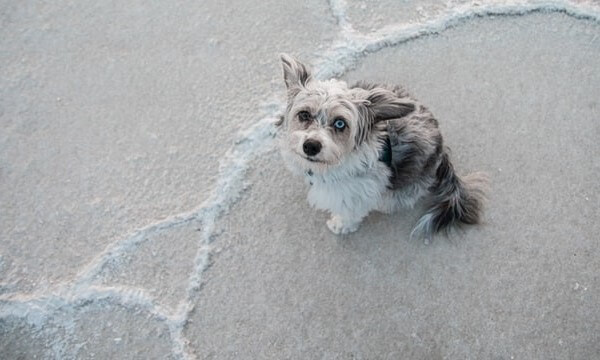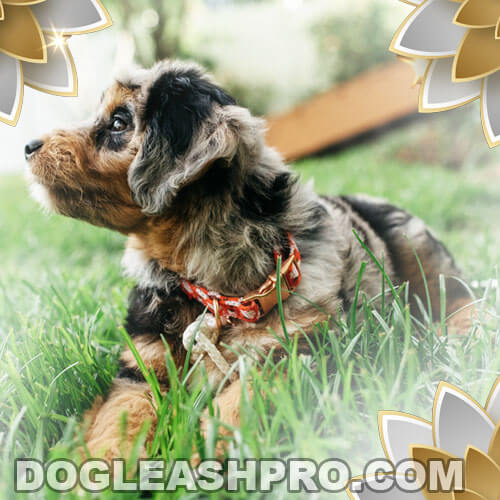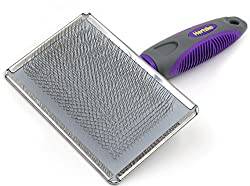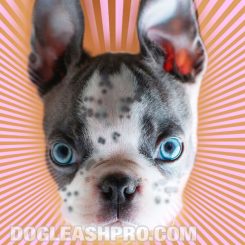

Are you looking for a canine companion that is loyal, intelligent, easy to train, energetic, friendly, and eager to please? If so, look no further than the Aussiedoodle. Aussiedoodle is a hybrid dog breed that is quite popular amongst families with both older and younger children.
When it comes to one of the most popular Poodle mixes in the US, Aussiedoodles undoubtedly make the cut. They come in various coat colors and patterns including the Blue Merle pattern. If the Blue Merle pattern piqued your interest, keep reading!
In this comprehensive guide, we’ll discuss everything you need to know about the Blue Merle Aussiedoodle. If you would like one after reading this, we’ve included a list of breeders you can reach out to. Let’s begin with a brief overview of the Blue Merle Aussiedoodle.
Table of Contents
Blue Merle Aussiedoodle: Breed overview

The Australian Poodle is an intelligent, playful, and loyal designer dog breed that is becoming one of the more popular Poodle mixes around. They are known by other nicknames such as Aussiepoo or Aussiepoodle.
They come in a variety of colors and coat patterns with the Blue Merle Australian Shepherd Doodle being highly sought after because of their unique coat color. Aussie Doodle Blue Merle is usually a product of a male standard or miniature Poodle and a female Australian Shepherd dog that has the Merle pattern.
| Blue Merle Aussiedoodle | |
| Purity | Hybrid dog |
| Purpose | Companion dog |
| AKC Recognition | No |
| Size | Medium |
| Weight | 25-70 pounds |
| Height | 10-15 inches |
| Coat Colors | Gray, Black, White, Tan, Blue Merle |
| Child Friendliness | High |
| Canine Friendliness | High |
| Training Difficulty | Easy |
| Grooming Upkeep | Moderate |
| Exercise Needs | High |
| Health | High |
| Lifespan | 10-15 years |
| Puppy Cost | $3,000 average |
Related Article: German Shepherd Poodle Mix (Shepadoodle Complete Guide)
What is an Aussiedoodle?
An Aussiedoodle is a hybrid of the standard or miniature Poodle and the Australian Shepherd dog.
What is a Blue Merle Aussiedoodle?
A Blue Merle Aussiedoodle is an Aussiedoodle that exhibits the Blue Merle pattern in his coat. Parts of their coat have irregular patches of white, gray, and blue with some having tan points on some parts.
Also read: Blue Poodle (Complete Guide)
Are Blue Merle Aussiedoodle recognized by AKC?
No, Blue Merle Aussiedoodle is not recognized by the AKC. The American Kennel Club (AKC) does not recognize this breed since this is not a purebred dog.
Aussiedoodle Blue Merle genetics

The Merle pattern is caused by a dominant gene expressed as ‘M’. When one parent has this dominant gene, there is a high probability that one of the offspring in the litter would have the Merle pattern on his coat.
There are two types of Merle: the Blue and the red. A Blue Merle is simply a black dog whose base coat color is diluted by the Merle gene. Similarly, a liver-coated dog that inherits the Merle gene is called a red Merle.
Aside from changing the base color, the Merle gene also alters the color of the eyes, nose, and paw pads. That is the reason why some Blue Merle dogs have blue eyes because the Merle gene modifies the pigmentation of the eyes.
Read also: Red Poodle (Complete Guide)
Aussiepoo Blue Merle physical appearance
Since the Aussiepoo is a designer breed, they don’t have a standard appearance you can expect. It all depends on whose genes are more dominant. But, generally, they have round heads, floppy ears, and short muzzles with some displaying mustaches.
Their eyes are round and they can be of various colors: blue, brown, green, or amber. The Aussiepoo Blue Merle may also exhibit heterochromia, where one eye has a different color from the other one.
You may also like: Pitbull Poodle Mix (Complete Guide)
Aussiepoo Blue Merle coat color and types
The Aussiepoo Blue Merle can have curly, wavy, flat, or straight furs. Some may also exhibit a double coat with the inner layer being thick and dense and the outer layer being stiff and coarse.
There are variations of the Blue Merle Aussiepoo with the most common having a base color of gray with spottings or dapplings of black.
Don’t miss: Merle Poodle (Complete Guide)
Phantom Blue Merle Aussiedoodle
Blue Merle Phantom Aussiedoodle has tan or copper points on their face, eyebrows, chest, and legs aside from the Blue Merle pattern on their body. There is also little to no markings of white.
SEE ALSO: Phantom Poodle (Complete Guide)
Blue Merle Tri Aussiedoodle
This variation has the Blue Merle pattern of black patches on a white/gray coat with tan points on the face, ears, legs, and chest.
Blue Merle Aussiedoodle with blue eyes
Most Blue Merle Aussiedoodles will have blue eyes with some brown specks. It is also possible to have brown eyes with blue specks.
Other popular Aussiedoodle colors
There are many colors an Aussiedoodle can have since the Poodle and the Australian Shepherd varies both in their coat colors and markings. Here are several popular Aussiedoodle colors:
Red Merle Aussiedoodle
A red/brown base color with some white and tan points.
Black and Chocolate Aussiedoodle
Dark brown and black colors dominate with some tan or white points.
Red Tri-color Aussiedoodle
Red color dominates with some black, brown, or white points in the head and body.
Black Tuxedo Aussiedoodle
Black coat with white patches around the neck and chest.
Sable Aussiedoodle
Tip of the hair strand is black with a base of tan, gray, or beige.
Blue Merle Aussiedoodle size, height, and weight
The height and weight of a Blue Merle full grown Aussiedoodle is determined by a number of factors, such as, the size of the Poodle parent and the generation of the Aussiedoodle. It is very unpredictable to get the size of a Blue Merle Aussiedoodle adult, but here is a chart with the rough estimate.
| Weight | Height | |
| Male | 12-70 pounds | 12-25 inches |
| Female | 10-65 pounds | 10-23 inches |
Full grown Blue Merle Aussiedoodle
One factor that could determine the height and weight of a Blue Merle Aussiedoodle full grown is the size of the Poodle parent since they come in different sizes. It can be one of three sizes: toy, mini, or standard.
Blue Merle Mini Aussiedoodle
A Blue Merle Miniature Aussiedoodle can reach half of its weight by the time they are 5 months old. Blue Merle full grown Mini Aussiedoodle weighs between 15 and 45 pounds and stands at a height of 10 to 15 inches.
Mini Blue Merle Aussiedoodle is usually a product of a Miniature Australian Shepherd and a Mini Poodle. And, Mini Aussiedoodle Blue Merle can be hard to find due to their unique color and size.
The size of the Miniature Blue Merle Aussiedoodle should not fool you into thinking they are less active than their larger counterpart. The Blue Merle Aussiedoodle Mini is just as energetic, agile, and intelligent and would need the same kind of care as any Aussiedoodle.
A problem that might arise from a full grown Blue Merle Mini Aussiedoodle is that they may have crowded teeth due to their small mouths. Blue Merle Mini Aussiedoodle full grown may be prone to teeth loss and periodontitis.
Handy Hint: It’s best to brush your canine friend’s teeth at least 2 to 3 times a week. Be sure to use a dog toothpaste that contains both enzymatic formula and non-foaming agent. Dog toothpaste that contains these two elements will help to remove plaque, control tartar formation, freshen your dog’s breath while ensuring that it is safe to swallow.
Blue Merle Toy Aussiedoodle
A Toy Aussiedoodle Blue Merle will achieve half of its adult weight at around 3.5 months of age and level off at around 8 to 11 months. Their typical weight is 10 to 15 pounds with a height of 10 inches or less.
Standard Blue Merle Aussiedoodle
The adult standard Aussiedoodle will weigh between 45 and 70 pounds and stand between 15 and 25 inches.
Various Blue Merle Aussiedoodle generations
Aside from the different sizes an Aussiedoodle can have due to the Poodle’s three size varieties, size can also be determined by their generation. A generation refers to the percentage of their genetic makeup and the letter ‘F’ is used to denote it. Further generations are denoted as F1b, F1bb, F2, F2b.
F1 Blue Merle Aussiedoodle
An F1 Aussiedoodle is the offspring of a purebred Poodle and a purebred Australian Shepherd. This gives it a 50-50 mix. If one of the parents have the dominant Merle gene, then it’s likely that one of the puppies in the F1 Aussiedoodle litter will be Blue Merle.
Blue Merle F1b Aussiedoodle
Blue Merle F1b Aussiedoodle has an F1 Aussiedoodle parent and a purebred Poodle parent. This means that it is 75% Poodle and 25% Australian Shepherd.
Blue Merle Aussiedoodles temperament and personality
Aussiedoodles are generally highly energetic and enthusiastic. They are not suited to be left alone for long periods of time. Boredom could lead to anxiety and destructive behaviors around the house.
Do Blue Merle Aussiedoodles make great family pets?
Yes, Blue Merle Aussiedoodles do make great family pets. They are great family pets especially for active families. The Blue Merle Aussiedoodles are known to be friendly but may have the tendency to nip or bite playfully due to the herding behavior of the Australian Shepherd.
Aussiepoo Blue Merle training
Aussiepoos are highly intelligent and can be trained easily. They are eager to learn new tricks and can be taught new commands with only few repetitions as long as they are given positive reinforcements.
Check out: How to Crate Train A Puppy in 6 Steps
Aussiepoo Blue Merle exercise requirement
Because of their high energy, they need an outlet to release that pent-up energy. You would need to take them for a walk or for a run for at least 30 minutes to one hour daily.
When taking your Aussiepoo Blue Merle out for a walk or run, be sure to use either a retractable dog leash or a rope dog leash to keep him safe and walking nicely next to you.
Aussiepoo Blue Merle living conditions
Aussiepoos are well suited to live in any living conditions even in small apartments provided that they get the proper exercise they need everyday.
Many dog owners with a backyard allow their Aussiepoo to roam freely in their yard during the day. This ensures that their pooch gets enough playtime, fresh air, and sun. If you also allow your canine friends to play in the backyard, make sure your backyard is fully fenced.
If your county’s zoning law doesn’t allow physical fences, install a wireless dog fence instead. This will keep your furry family members safe and prevent them from becoming the next Harry Houdini.
Before you install a wireless dog fence, make sure you have an electronic dog door installed. Many owners love the electronic dog door (or two) because they can program and customize the curfew hours. This way, their pups are able to go out on their own and play during the day while staying safe indoor at night.
Blue Merle Aussie Doodle grooming and cleaning
For the most part, Aussiedoodles need moderate grooming. They need to be groomed with a slicker brush from top to tail to remove any matting and to also distribute the natural oils throughout their body.
When bathing your pooch, use only mild dog shampoos and conditioners to avoid irritation.
Their ears should also be checked regularly for any wax buildup and fungal infections.
Additionally, teeth should be cleaned several times a week with a dog-friendly toothpaste to avoid any tartar buildup, especially since smaller Aussiedoodles are prone to dental diseases.
| Grooming Needs | Frequency |
| Brushing | 2 to 3 times weekly. |
| Bathing | Once or twice monthly. |
| Ear cleaning | Weekly. |
| Nail trimming | As needed. |
| Teeth brushing | 2 to 3 times a week. |
Blue Merle Aussiedoodle haircuts
One of the best things about a Blue Merle Aussiedoodle is you can change his haircuts depending on the season and to your liking, too. Here are some examples:
Aussiedoodle puppy cut
This is not just for pups but for adults as well. The body is shaved leaving just a few inches of hair. But the hair on the ear area is left a bit longer and fluffy. This is the perfect cut during the summer season.
Teddy bear cut
Closely similar to a puppy cut except that the hair on the face is kept longer and shaped into a ball.
The Mohawk
If you and your Fido are up for a more daring look, why not opt for a Mohawk look? The entire body is shaved leaving only a chunk of longer hair at the center of its head.
Do Blue Merle Aussiedoodle shed?
Shedding is more common among Aussiedoodles that have straight fur. Those with other types of coat will be little to moderate sheders.
RELATED: Do Aussiedoodles Shed?
So, is a Blue Merle Aussiedoodle hypoallergenic?
A Blue Merle Aussiedoodle can be considered mildly hypoallergenic. Australian Shepherds are not hypoallergenic but the Poodles are. So, it is safe to say that the Poodle gene contributes to the Aussiepoodle less shedding characteristic.
Blue Merle Aussie Doodle food and diet
To optimize the health of a Blue Merle Aussie Doodle, you have to give him a well-balanced diet of protein, carbohydrates, and fats. He should be fed with high-quality kibble dog food of about 2 to 3 cups, divided into 2 meals.
You can also give him wet dog food which is a better choice if your Fido is on a diet. This is because wet/canned dog food has a higher water content that helps your four-legged friends feel fuller faster.
Check out: Can Dogs Eat Mushrooms?
Blue Merle Aussiedoodle health problems
Though they are considered healthier than their purebred parents, they can still face some of the common health problems of their parents like the following:
1. Hip dysplasia
A painful condition, hip dysplasia commonly affects larger dogs. This condition usually occurs during your puppies’ growth and development stages. The ball and the socket of the hip fail to fit together.
2. Hypothyroidism
A majority of the cases are the result of an immune system that is overly active. No one knows for sure why this happens but most experts blame it on genetics. Some of the signs are weight gain and intolerance to cold weather.
3. Von Willebrand’s
A bleeding disorder caused by a lack of protein responsible for blood clotting. The signs include continuous nose bleeding and excessive bleeding during nail trimming.
Handy Hint: If clipping your dog’s nail is causing bleeding or you have a tendency to clip the quick, try using a dog nail grinder instead. Dog nail grinders are quiet since it features whisper-quiet motor with a precision diamond drum bit grinder. Give it a try and see if it makes a huge difference.
4. Cataracts
It is a misconception that only older dogs develop cataracts. Genetics and diabetes also cause this eye disorder. If not treated early on, it can worsen and lead to blindness.
Don’t miss: How To Soften Dog Eye Boogers?
5. Epilepsy
A neurological disorder that causes seizures.
Blue Merle Aussie Doodle lifespan
Given the right care, the Blue Merle Aussie Doodle has an average lifespan of more than 10 years with the smaller ones tend to live longer.
Blue Merle Aussiedoodle breeders
We cannot emphasize enough the importance of only dealing with reputable and ethical breeders. In case you find a Blue Merle Aussiedoodle puppy that is being sold way below the average price, you can be certain that it is a product of puppy mills.
Do not think twice about paying a much higher price because this only encourages backyard or less scrupulous breeders.
You’ll want to go with a responsible breeder that can guarantee you the physical and behavioral health of the pup.
Blue Merle Aussiedoodle puppies
If you’re looking to buy a Blue Merle Aussiedoodle puppy from a trusted breeder, you will be able to pick an Aussiedoodle Blue Merle puppy from a litter.
We highly recommend that you take your time to observe the energy level of the Aussiedoodle puppies Blue Merle and pick the one that is active and playful. Sometimes, the Blue Merle Mini Aussiedoodle puppies that are not interested in playing may have some health or behavioral problems.
Then, pick a Blue Merle Aussiedoodle puppy that has bright eyes, a shiny coat, and clean ears. But, always remember that before taking the puppy home with you, all the essentials for the puppy’s comfort are already in place.
Blue Merle Aussiedoodle price
One of the initial concerns for those wanting to own this adorable dog breed is how much do Aussiedoodles cost?
Well, Blue Merle Aussiedoodles, regardless of age come with an average price tag of $3,000.
The other expenses include veterinary care and microchipping. Furthermore, invest in the following basic doggie stuff with an average price of:
- Bed: $30 – $70
- Crate: $45 – $70
- Collar: $9 – $23
- Leash: $10
- Grooming tools: $12 – $35
- Potty pads: $25
You may be interested in: Best Chew Proof Dog Beds (Reviews & Top Picks)
Blue Merle Aussiedoodle puppies for sale near me
Searching for Blue Merle Mini Aussiedoodle puppies for sale near me?
Allow us to help you find the perfect Aussiedoodle Blue Merle puppies for sale. No need to worry because even if the breeder is far from where you are, they usually have links with pet delivery services worldwide.
Sunny Ridge Doodles (sunnyridgedoodles.com) located in Temecula, CA has Blue Merle Aussiedoodle puppies for sale available worth between $4,500 and $6,500. If you’re keen on getting one of the Blue Merle Mini Aussiedoodle puppies for sale, you can send a non-refundable deposit of $500.
Are you from Utah or wondering where to find Mini Blue Merle Aussiedoodle puppies for sale near me?
Check out Canyon Creek Aussies (canyoncreekaussies.com) which has upcoming litters for which you can deposit a reservation fee of $500. The Mini Blue Merle Aussiedoodle puppies are sold for $4,000.
Finding a healthy Blue Merle Aussiedoodle for sale
Canyon Creek Aussies (canyoncreekaussies.com) also has healthy adult Blue Merle Aussiedoodles for sale starting at $4,000.
For Blue Merle mini Aussiedoodle for sale, you can visit Strahan Farms (strahanfarms.com) for adult dogs for sale.
Phantom Blue Merle Aussiedoodle for sale
Sometimes getting an adult dog is much better because you no longer have to deal with issues such as potty training and teething. If you’re interested, you can send a message to the breeder below:
Awesome Doodles (awesomedoodle.com) is one of the best Doodle breeders in the USA. As responsible breeders, they provide buyers with genetic testing results of all dogs for sale. If you’re lucky today, they may have an adult Phantom Blue Merle Aussiedoodle for sale. If not, you can ask for referrals.
If you’re looking to identify your mixed dog’s exact breed information, try Embark dog DNA test. This doggy DNA test features both breed identification and health detection:
Blue Merle Aussiedoodle: Pros and Cons
Still, deciding if you want to get a Blue Merle Aussidoodle? Here are the pros and cons to help you make up your mind.
| Pros | Cons |
| Very easy to train. | Does not tolerate being left alone. |
| Do not bark too much. | Needs constant attention. |
| Low shedder. | Hair gets matted easily. |
| Comes in different colors. | Quite expensive to buy. |
| Very loving and playful. | Needs plenty of daily exercises. |
| Friendly with kids and other pets. | Can get destructive if left with nothing to do. |
Is the Blue Merle Aussiedoodle right for me?
Is there someone always present in your household? Are you prepared for some play time with this dog? Are you willing to bring this dog along with you during your outdoor trips? Does working out with a dog appeal to you? If you answered ‘yes’ to these four questions, then the Blue Merle Aussiedoodle may be the canine companion for you.
Related Questions
A Blue Merle Aussiedoodle can be pricey as their average price tag is around $3,000.
Phantom Red Merle is the rarest color of Aussiedoodle. That’s because a phantom color in itself is hard to produce, even more, if mixed with a red merle coat pattern.
DISCLAIMER: THIS WEBSITE DOES NOT PROVIDE MEDICAL ADVICE
The information, including but not limited to, text, graphics, images and other material contained on this website are for informational purposes only. No material on this site is intended to be a substitute for professional veterinary advice, diagnosis, or treatment. Always seek the advice of your veterinarian or other qualified health care provider with any questions you may have regarding a medical condition.
Resources:
https://www.akc.org/expert-advice/dog-breeds/mixed-breed-purebred-health/

With over five years of specialized experience as an animal writer, my expertise lies in dog nutrition, health, behavior, grooming, and training. I am dedicated to delivering helpful and informative content that caters to the well-being of our furry friends. My primary goal is to empower pet owners with knowledge and ensure our canine companions thrive in health and happiness. In my free time, I love volunteering at local dog rescue centers.









